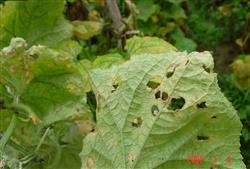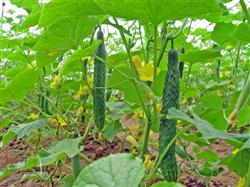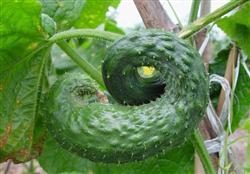What harm does cucumber anthracnose have?

What harm does cucumber anthracnose have? What method can prevent and cure cucumber anthracnose? Also ask netizens to help guide the harm and control methods of cucumber anthracnose can refer to the following introduction: the harm of cucumber anthracnose: anthracnose can occur both at seedling stage and adult plants. The disease occurred at the cotyledon stage, with a yellowish-brown semicircular spot on the edge of the cotyledon and slightly sunken. When the adult plant is damaged, the water-immersed disease spot appears on the leaf, and gradually expands into a nearly round brown color, and there is a circle of yellow halo spot in the outer circle, the typical disease spot is 10-15 mm, the disease spot often becomes irregular patches, orange-red sticky matter grows on the disease spot when the humidity is high, and sometimes star-shaped rupture or shedding perforation occurs in the middle of the disease spot when it is dry, and even the leaves dry and die. The disease spot on the petiole or stem is often sunken, and sometimes there are pink dots on the surface. The disease spot changes from yellowish to brown or gray. If the disease spot spreads to a circle of the stem, the stem vine dies. At the initial stage of infection, the melon strips showed light green water-immersed spots, and soon became dark brown, expanding and sunken, with dark color in the middle and many small black spots in the upper part. when the humidity was high, the disease spot was frog-like, and pink sticky material was produced on the surface of the disease spot in the later stage. often cracking, the diseased fruit is bent and deformed. The cause of cucumber anthracnose: a fungal disease caused by Alternaria spp. The temperature range suitable for the disease is wide, and the disease can occur at 10-30 ℃. The pathogen stopped growing below 8 ℃ and above 30 ℃, and 24 ℃ was the most suitable for bacterial growth. The disease is serious when the humidity is high, especially at more than 95%, develops rapidly, and does not occur when the humidity is less than 54%. The pathogen of anthracnose can survive the winter in the soil with the disease residue, it can also be attached to the seed surface, and the field shelves and facilities can also carry bacteria, which are the initial infection sources of the disease in the coming year. The disease is more common in wet protected land and open field rainy season, and it has become the main disease in some areas. Methods for prevention and control of cucumber anthracnose: method 1, seed disinfection: soak the seeds with 50-55 ℃ warm water for 15 minutes, or soak the seeds with 40% aldehyde (formalin) for 1 hour, or soak the seeds with 50% ammonium bromide for 1 hour, or soak the seeds with glacial acetic acid for 30 minutes, then rinse them with clean water and then accelerate germination. Method 2. Cultivation measures: select varieties resistant to anthracnose, such as Jinyan 4, Xiafeng 1, Zhongnong 5, etc.; pay attention to the hygiene and disinfection of bed soil when raising seedlings, disinfect bed soil with carbendazim, and use chlorothalonil smoke scavenger to fumigate greenhouse and its agricultural tools and frame materials for raising seedlings; cultivate strong seedlings and improve the disease resistance of seedlings In cultivation, more phosphorus and potassium fertilizer should be applied, foliar fertilization should be carried out frequently to enhance plant resistance; diseased leaves and plants should be removed in time, and clean stubble should be removed when changing stubble; the seriously affected plots should be rotated for 3 years. Method 3. Chemical control: 50% suitable carbendan 1000 times, 20% mancozeb 200 times, 70% mancozeb 1000 times, 80% anthrax magnesium 800 times, 50% methyl thiophanate wettable powder 1500 times, 75% chlorothalonil 1500 times, 50% carbendazim powder 1500 times, 50% carbendazim powder 1500 times, carbendazim 300 times, spray once every 10 days, spray 3 times continuously All kinds of medicine can be used alternately. It can also be sprayed with 2% agricultural antibiotic 120 water agent 200x liquid, or 2% BD-10 150g 200x solution for biological control. Method 4. Daily prevention and control: in the protection facility, 5% chlorothalonil dust, 5% carbendazim dust and 12% carbendazim dust can be used for powder control, and the effect is better; 45% chlorothalonil smoke remover can also be used. Click to get more cucumber cultivation techniques click to get more vegetable planting techniques
- Prev

Cucumber cultivation techniques: how to top fertilize cucumber planting?
How to top fertilize cucumber planting? There are no netizens to introduce the method of cucumber planting in order to obtain high yield, it is necessary to top fertilizer according to the characteristics of cucumber fertilizer, the following methods of cucumber topdressing are introduced for your reference: method 1, fertilization method before planting to set melon: soil temperature in the early growth stage of cucumber (generally within one month after planting).
- Next

Cucumber cultivation techniques: what is the reason for the formation of cucumber malformed melons?
What is the reason for the formation of cucumber malformed melons? Also ask friends to help introduce that malformed melons often occur in cucumber cultivation, which seriously affects the economic benefits of producers. The following introduces the causes of various deformed melons for your reference. 1. Curved melon: dense stems and leaves, narrow row spacing, poor ventilation and light transmission, no fertilizer.
Related
- Where is it suitable to grow horseradish in China? it is expected to see the middle altitude horseradish in Alishan.
- How to prevent tomato virus disease reasonably? (Control methods included)
- Many people like to plant towel gourd on the balcony. What are the main points of this method and management?
- What crops can chili peppers be mixed with?
- Fertilization techniques and matters needing attention in Tomato
- What are the grafting techniques for peach seedlings in spring?
- Harm and control methods of root swelling disease of Chinese cabbage
- What are the pests of sweet potatoes? How to prevent and cure it?
- Symptoms, causes and Control methods of navel Rot in Tomato
- The cause of "Cucumber rotten bibcock" in Farmers' planting Cucumber and its Control Plan

